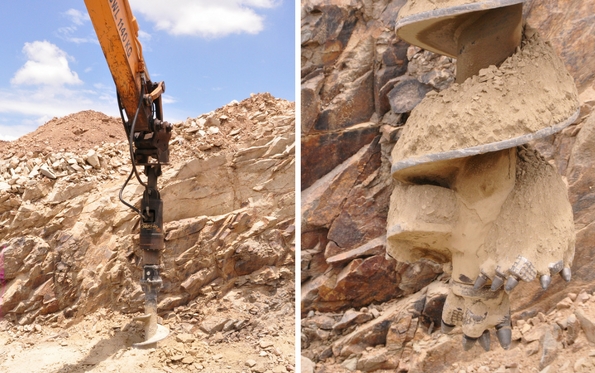Digga tips - best practice when drilling in rock.
Are you having trouble drilling in hard rock? We can help you out with some tips to make your job easier.. and more efficient! Without damaging your drillhead or wearparts.
Let us explain why rock drilling may cause difficulties and issues when not carried our correctly: When drilling rock or frost for extended periods of time, air is trapped in the hole creating an oven effect. The trapped temperature and friction causes the wearparts and pilot to heat up to an extreme temperature, causing them to melt. It will damage the drilling head and can result in the face of the rock to 'glaze over' and become an even harder surface. This is why we recommend that you periodically remove the auger from the hole to allow fresh air back in the hole every 5 minutes. This means - stop drilling and bring the auger head to the surface to allow air into the hole.
Below is an example of an auger, which was left down the hole for too long.
While it may seem excessive to have to bring the auger out every few minutes, you will find you will actually drill the hole quicker and be more efficient with your wearparts!
Let us explain why rock drilling may cause difficulties and issues when not carried our correctly: When drilling rock or frost for extended periods of time, air is trapped in the hole creating an oven effect. The trapped temperature and friction causes the wearparts and pilot to heat up to an extreme temperature, causing them to melt. It will damage the drilling head and can result in the face of the rock to 'glaze over' and become an even harder surface. This is why we recommend that you periodically remove the auger from the hole to allow fresh air back in the hole every 5 minutes. This means - stop drilling and bring the auger head to the surface to allow air into the hole.
Below is an example of an auger, which was left down the hole for too long.
While it may seem excessive to have to bring the auger out every few minutes, you will find you will actually drill the hole quicker and be more efficient with your wearparts!
By lifting the auger out of the hole it allows air back down, which consequently cools the teeth tips and also allows you to check the teeth and replace if necessary – they are after all wearparts.
We commonly hear of people adding water to the hole, which will make the spoil easier to remove. However this alone is not the answer! The frequency of removing the auger from the drill face has a much greater benefit. When drilling rock a small amount of water will certainly help to bind up the spoil, clear the head easier and help cool the teeth down but as we all know, water is not always readily available, especially on remote worksites.






Comments
Post a Comment